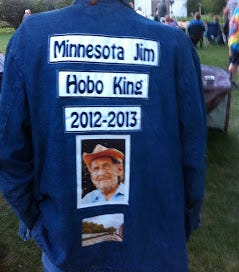Tourist Union no 63

During my recent trip to Iowa it was my great pleasure to attend the Hobo Festival in Britt, Iowa, where I was able to meet some of the delightful and colourful characters that come every year to celebrate the hobo culture. I wrote about this in the Economist a few weeks ago, where I explain how I came to acquire my hobo name Mad Scrip.
Tourist Union no 63, the title of this post, was the name of the original hobo union. Great name. I think I need to get a t-shirt made or something.
Hobo culture
Riding the rails
A report from the National Hobo Convention
Aug 17th 2013 | BRITT, IOWA |From the print edition
THEY found the Hardrock Kid under a tree in Ogden, Iowa back in 1977. He was on his way to the National Hobo Convention in Britt when he stopped for lunch and quietly passed away. In hobo vernacular: he caught the Westbound. His body is buried in the hobo cemetery in Britt; his humble possessions are displayed in its museum, which celebrates wanderers. On a glass shelf are toothpaste, a toothpick, some cutlery, a razor, a reel of cotton, a needle, cigarettes and a pair of pliers.
Hobos have long been misunderstood. People call them bums, often prefaced with the word “lazy”. Yet life on the road is arduous. Hobos travel to find work for food and lodging, an old tradition. In the late 1800s, 63 of them started a union with a small subscription fee and a set of laws. These, among other things, told members not to abuse handouts, to respect nature, and wherever possible to find work and stay clean. Linda Hughes, who works at the National Hobo Museum in Britt, says that hobos were the first migrant workers and that they helped to build America.
During the Depression there were probably hundreds of thousands of them, including many teenagers. Few were paid-up union members. But some of the better-known were poets, artists and dreamers. “Tramp art” has become collectable: hobos engraved cameos on nickels, made models with matchsticks and carved intricate designs on cigar boxes.
Minnesota Jim, who attended the 113th convention this year, has a weather-beaten face like a map of the world. He says he rode the rails in the 1940s out of a sense of “curiosity and adventure” before settling down. He washed dishes, picked cotton and potatoes, and worked in a lumber mill.
Another hobo, a young woman with blond dreadlocks and bare feet, says she is on her way to Oregon to work on the marijuana harvest. She says she loves small towns; she ran away from a pimp in St Louis, a city she describes as both “dangerous and boring”. In some ways, things are tougher on hobos these days, says Minnesota Jim. It used to be easy to hitch a lift (traffic was slower) or hop on a goods train. “We didn’t have any trouble with the police,” he sighs. [More...]



